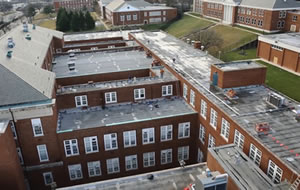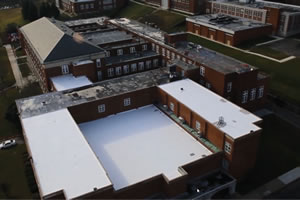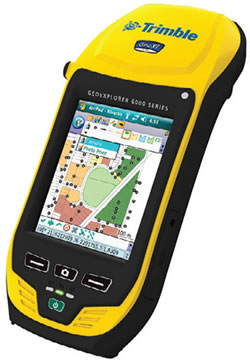The End of Worst First - Roofs in Transition

PHOTOS COURTESY OF BLUEFIN LLC
How do you know when your roof program is successful? If you answered, “If there are no leaks when it rains,” you are in the majority of facility directors. Not having a problem is certainly one measure of a maintenance program’s success, but this elephant repellant approach (you don’t see any do you?) begs the question about a better way.
Typically we create a prioritized list of the usual suspects for a roof replacement for the coming year by reviewing the frequency and severity of leaks from the previous year. Richard Rast, of Bluefin LLC, a national roof asset management firm, says this “worst first method is often the least effective thing you can do to preserve your facility assets, particularly in roofing.”
Why? Most roof replacement programs are underfunded. So only the very worst roofs get replaced. Those roofs that could benefit from a life-extending rehabilitation are deferred. Often until they fail. At the end of the warranty period, when a roof first appears on the replacement list, restoration costs about 75 percent less than a complete tear-off and replacement. But few are restored then. This endless cycle of failure and complete replacement is not only more costly overall, but also inefficient.
With the advent of new roofing materials and creative uses for some old materials, a few district facility directors are now reconsidering the priorities of their roof management program. Instead of sending their 15-or 20-year-old roofs to the landfill, they are now including life extension as part of their evaluation of roofing priorities. This is not simply life support or triage, but the analysis of when a complete roof replacement is appropriate and when to use alternative means or new materials to extend the serviceable life of a roof. Some are even foregoing the additional cost of an extended warranty.

PHOTOS COURTESY OF BLUEFIN LLC
Work in Progress. The roof restoration of the Browne Education Campus, which was completed by DC Public Schools, will double the useable life of the roof. There are similar projects district wide, which started with an extensive condition assessment and preventative maintenance plan. Since the first year of this plan, both the incidence of leaks and the need for capital funding have been substantially reduced, making more funding available for classroom enhancements.
Most flat and low-slope roofs are covered with thermoplastic polyolefin (TPO), ethylene propylene diene terpolymer (EPDM), poly-vinyl chloride (PVC), a PVC/ vinyl hybrid and asphalt built-up roofing. Liquid roofing is also gaining market share and is another option. Liquid roofing is a monolithic, fully bonded, liquid-based coating. Once applied, the coating cures to form a membrane, capable of stretching and returning to its original shape without damage. These fluid-applied coating systems are usually reinforced with secondary materials such as glass-reinforced plastic that provides additional tensile strength. The coatings and the sheet materials are generally lightweight enough to be applied over most existing roofs. All of these materials perform well, but there is always a danger of becoming victims of our own experience. We often rely on what we used in the past instead of basing decisions on site-specific conditions, depending upon the qualities of the substrate over which materials are applied.
In a traditional roofing program, the in-house patch and repair teams or the contracted service teams are on call for leaks. A 24-hour response time is the industry standard. This emergency response experience is sometimes rewarding (particularly for those on the team that can truly stop the leaks with one visit), but it is stressful for those that field the constant calls and complaints. It is particularly frustrating for administrators dealing with chronic incidents. Truth is, you don’t really know if the leak is fixed until the next rain event. It’s not uncommon with a chronic problem to send a team multiple times before the sheer volume of roofing cement applied ultimately stops the leak.
Under a more strategic roof management plan the leak response teams do more preventative maintenance and less emergency response. Infrared scans have been the stock in trade of roofing consultants for a great many years, but even today they are often used to determine whether or not to replace a roof and not whether or not to restore it. Today’s scans are accurate enough to determine the extent of the moisture intrusion as a guide to making better informed roofing decisions.

Roof in Hand. There are GPS devices that are capable of creating very detailed and accurate diagrams of a school roof — and even specific sections of a roof. This technology can be used to map and document the condition of the roof at the beginning of a project and maintain electronic records of every inspection and every repair performed.
Most facility managers prefer to replace an entire roof at a site rather than deal with each portion of the roof individually. While a larger order of magnitude would seem to cost less per square foot because of the cost of mobilization, the significantly lower costs of restoration offset the substantial costs incurred in the larger project. Decide how best to handle each portion of roof independently and proceed accordingly.
The same GPS technology that gives us driving directions now makes it possible to locate roof features with precision. Roof assessments using this technology produce highly accurate diagrams of each roof and its features for the inventory and the preventative maintenance lists. This tool works well during the preventive maintenance work too. An in-house technician inspecting and maintaining a specific roof detail (e.g. a pitch pocket) can take a photo before and after the work, and identify the location with the handheld GPS device.
If an assessment is to be done, it is far more efficient and less expensive to have a certified roofing technician do the inspection and the minor repairs during the assessment. It also reduces the number of items requiring immediate attention to a small bid package.
The decision to employ a more strategic roof management plan can be a significant change for many facility directors. They usually have been forced to neglect their infrastructure because of budget constraints, and the upgrade to a more comprehensive approach can initially be more expensive than simply doing emergency repairs. For that reason, the initial decision to proceed is often as a result of an influx of funds from a bond referendum or annual fund balance. The idea of being able to address a large number of roofs at one time rather than a handful that have failed is an attractive alternative. Taking the long view has proven to be more economical.
The program manager for Washington D.C. Public Schools has successfully doubled the useable life of all roofs in their inventory. District-wide roof management started with an extensive condition assessment and preventative maintenance package. Certified roofing technicians did the inspections and the remedial work. Later phases included partial replacements and roof restorations based upon the conditions discovered with the inspections and infrared scans. Since the first year of this plan, both the incidence of leaks and the need for capital funding have been substantially reduced. This has meant more funding available for classroom enhancements.
Infrastructure improvements cannot be postponed indefinitely and the worst first methodology has a built-in catastrophic spiral of roof failures. Throughout the country many seasoned facility managers that use a worst first approach are hoping that their retirement date arrives before a serious roof failure. A more strategic approach to roof asset management using new materials and tools, partial replacements, restorations and regular preventive maintenance may offer a better alternative.
This article originally appeared in the issue of .